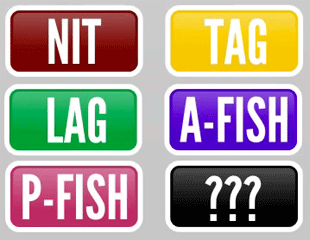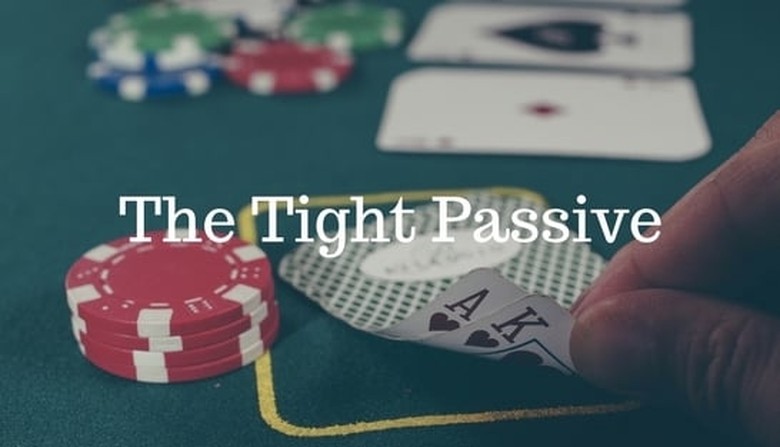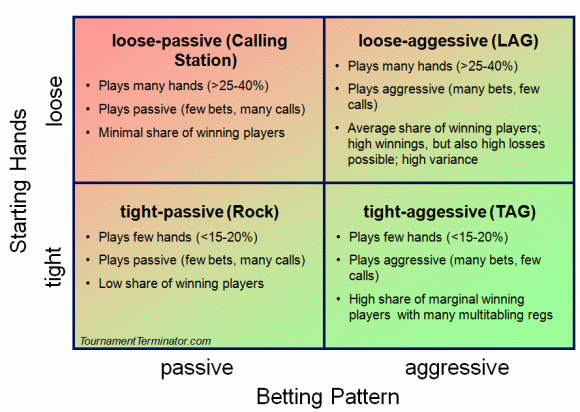Poker Aggressive Or Passive
- Poker Aggressive Or Passive Immunity
- Poker Aggressive Or Passive Infinitive
- Poker Aggressive Or Passive Aggressive
In poker, the general advice to 'be more aggressive' is often given. Regardless of the variant, players are often told that the benefits of playing aggressively are many, and that failing to be aggressive reduces our chances of success.
This is a warning sign that you are moving away from the aggressive strategy essential to winning at poker. Winning players have a tight gap between their VPIP and their PFR. A quick rule of the thumb is that the higher the PFR, the more aggressive a player is. Our poker tutorial is a great way to learn the card game loved by millions. /515033-Aggressive-Play-vs-Passive-Play-Poker-Tutorials Hey, I'm Nicky Numbers, I'm a professional poker player and I'm.
Less often provided are specifics regarding how and when to apply such aggression. Usually if any elaboration of the point follows it ends with a brief discussion of why aggressive players tend to enjoy more success than those who are passive.
Betting and raising are actions that inform an aggressive style, while checking and calling are ones that inform a passive style. Both should be understood as distinct from a player being 'loose' or 'tight,' terms which instead refer to the frequency of hands played (loose players play a high percentage of hands; tight players play a low percentage of hands).
We're told that aggressive players — those who often choose to bet or raise when given the chance to do so — don't have to wait for good hands to win pots, but can also win with lesser hands when their bets cause others to fold. Instead of only winning pots by making better hands, aggressive players have a second way to win — by getting others to fold (and sometimes even fold better hands).
Such advice is generally true and works as a good starting point for explaining why an aggressive style is preferable to a passive one. However, the general encouragement to bet or raise rather than check or call still lacks specific guidelines regarding how to be aggressive as well as when being aggressive is an advantageous strategy.
How to Be Aggressive
It's a little easier to talk about how to apply aggression — that is, to identify certain actions as aggressive — than it is to explain when to be aggressive. With regard to no-limit hold'em, players can distinguish themselves as aggressive in a number of ways, starting before the flop.

Those who open-raise and three-bet a lot often stand out as aggressive. Even new players soon discover only a relatively small percentage of starting hands are strong enough with which to raise or reraise, thus when players raise or reraise more often than such a percentage suggests, they are demonstrating preflop aggression.
Players who routinely raise to attack preflop limpers are also showing aggression, as are those who employ the 'squeeze play' (i.e., reraising over a raise and call).
On the flop, aggression again can be exhibited in several forms. A continuation bet that keeps the initiative with the preflop raiser is one example. So, too, is check-raising (an especially aggressive move). Floating the flop is another move aggressive players make, one that most often involves calling a flop bet with position despite having a marginal or weak hand in order to set up betting or raising as a bluff on a later street.

The turn is also where a check-raise can occur, among other types of aggressive moves. A bet or raise here might automatically be viewed as aggressive depending on the board and situation. For example, the turn card might complete a possible draw or create new ones, making the board 'scary' and thus causing any bet or raise to appear that much more aggressive.
The river can likewise bring such 'scary' cards that potentially improve drawing hands. Whether they do or not, a big river overbet — either for value or as a bluff — would be an example of aggression.
All of these moves are obviously situation dependent. In any case, a player making them frequently enough becomes marked as aggressive, and if the moves are well-timed and effective that player also stands out as a difficult one against whom to play.
When to Be Aggressive
Perhaps you've heard the very basic advice to beginners to 'bet if they check,' especially on the flop and regardless of their own hand strength. The idea is to encourage new players learn to be aggressive at times when aggression is warranted and likely an advantageous strategy.
More often than not we're dealt unpaired cards before the flop (pocket pairs only come once every 17 hands). And with unpaired cards, our chance of making a pair or better on the flop is a little worse than 1 in 3. That means when a player checks the flop, most of the time that player has yet to make a pair or better, which in turn suggests if we bet — that is, if we are aggressive rather than passive — we'll win the hand.
That's not a bad start to figuring out when to be aggressive. In fact, let's make it the first item on a short list of instances when it is likely good to employ those aggressive actions described above.
1. When your opponent shows weakness
As noted, checking after the flop is a sign of weakness. So, too, are actions like preflop limping, making small leading bets, check-calling, and other examples of passive play. Being aggressive is often a good response.
Incidentally, by 'weakness' here I am referring to hand strength and not the quality of the player. Weak players can often be loose — e.g., the 'calling station' against whom it generally isn't going to be a good idea to bluff with air.
2. When your opponents are tight
Again, be careful not to confuse being 'tight' with being 'passive.' A tight player plays relatively few hands, and thus is often only getting involved with very strong starting hands and/or continuing with strong made hands postflop. A passive player, meanwhile, likes to check and call (and with a wide range of holdings).
Against overly tight players, aggressive players can often thrive by picking up pots without having to make hands themselves. The key, of course, is to be aware when the tight player finally starts fighting back against all of your preflop raises and three-bets and postflop pot-stealing bets — that's when it's likely a good time to ramp down the aggression and let hands go.
3. When your opponents think you are tight
Perhaps you really are a tight player — indeed, a 'tight-aggressive' style can definitely be a winning one, if smartly applied. Or you've just encountered a bad run of starting hands and haven't been able to get involved for a while. In any case, if you think your opponents suspect you to be on the tight side, a sudden display of aggression is likely to earn respect.

In this case I'm talking more directly about bluffing than value betting. After all, you don't want to be that player who folds 20 hands then after finally picking up aces suddenly gets active only to see everyone fold. Squeeze plays, floats, check-raises, and turn and river bets on 'scary' boards are all aggressive moves that when made by a seemingly tight player are more likely to earn folds, and thus can be considered as bluffing opportunities.
4. When your opponent's range is capped
Sometimes a hand plays out in such a way that your opponent very likely can only have a medium-strength hand at best while your own range of hands is much wider, including many hands that could beat your opponent. A big turn or river bet (or raise) thus becomes very difficult for your opponent to call, even if the player has an overpair or something of similar value.
We're edging into slightly advanced strategy with this example — see Gareth Chantler's article 'Why So Much? An Exercise in Capping an Opponent's Range' for a fuller explanation of how an opponent's range limitation can be a good time to be aggressive.
5. When the game is short-handed
Finally, fewer players means you should widen your ranges for preflop raises and three-bets while also looking for more spots postflop to be aggressive.
Hopefully this overview provides a better, more concrete plan for players looking to start incorporating more aggression into their no-limit hold'em games. Learn what aggressive poker is (the 'how'), and especially work on recognizing spots both before and after the flop where it is most effective to employ such aggression (the 'when').
Tags
cash game strategytournament strategyno-limit hold’emaggressionpreflop strategypostflop strategystarting hand selectionpositionsqueeze playcheck-raisingoverbettingbluffing
While there are certainly infinite ways to play a tournament,
there are two basic approaches that tend to apply to the
majority of players. If you take an unbiased look at your play,
you should be able to aptly determine whether you would be
considered a passive or an aggressive player. For example, do
you like to flat call raises with AK, or will you make every
attempt to get it all in pre-flop? There’s nothing that’s
inherently wrong with either style of play, but it’s instead a
matter of combining the two strategies to form one optimal,
winning combination.
The stages of a tournament will always be the biggest factor
in how you should be playing. It makes little sense to be wildly
aggressive just as a tournament begins, just as it makes no
sense to be passive when there’s a significant number of blinds
up for grabs. Shifting gears is perhaps the single biggest thing
that a poker player can do in a tournament. Get caught speeding
in a slow zone and you’ll be busted. Slow down in the fast
lane and you’ll get burned.
Passive Play
Passive play is most ideal when you are in a position to
accumulate a lot of chips without putting yourself in a lot of
danger. As a general rule of thumb, with
turbos and other similar structures being an exception, the
early stages of a tournament will call for the most passive
play. At this point in an event, you should be working with a
large number of big blinds. You’ll also be able to see a
number of flops and will be afforded with the opportunity to
outplay your opponents in post-flop situations. As a tournament
progresses, however, these chances to win based on skillful
plays will be greatly diminished.
It’s important to define exactly what passive play is before
you attempt to implement it into your game. To some people,
passive play is simply playing a hand in a more laid back way
than would normally be advisable. While this is technically
correct, it does not always translate into winning passive play.
You need to be able to pick your spots exceptionally well if you
want to be able to adapt to the passive game plan.
Poker Aggressive Or Passive Immunity
Passive tournament play doesn’t mean that you should call
off every bet. There’s a big difference between seeing lots of
flops with playable hands and seeing lots of flops with any
hands. A lot of tournament players feel the need to get involved
in just about every pot. They will limp in, call raises, check
call bets, and so on and so forth. Needless to say, this is a
perfect illustration of the type of passive tournament play that
will be punished. While you aren’t going to typically lose your
entire stack in one shot with this type of play, you’ll likely
be bleeding off chips at a continuous pace. This is passive
tournament play, but it’s bad passive play.
Winning passive tournament strategy calls for players to get
involved in pots cheaply, but to also put themselves in
positions where their opponents are prone to paying them off. In
other words, look for hands that can allow you to
play in position with an aggressive opponent betting into
you. If you have hands that have lots of value when they hit the
flop, but are useless without improving, you are going to be in
a situation where you effectively apply passive play.
Think about a hand like 8s/9s. If someone raises, a re-raise might
take down the pot. In later stages of tournament play this may
very well be advisable. At most other points, however, calling
off a raise is a much better idea. Your losing nothing if you
brick, you make the most if you hit, and your opponent has
motivation to take the initiative in the hand. Use passive play
as a combatant against overly aggressive players.
Aggressive Play
Just as passive play works wonders against aggressive
players, so too does aggressive play work well against passive
players. There’s no easier way to understand how to instill an
aggressive style of tournament play than to consider what would
most effectively beat a passive player. This isn’t to say that
you should relentlessly be attacking a particular player simply
because they are passive, however. It will almost always be the
case that your style of play is a product of circumstance. Using
aggressive play, you should be looking for spots where you can
push opponents around without much fear of negative reactions.
Poker Aggressive Or Passive Infinitive
Think about the mid and later stages of tournaments. When you
are in late position with a small pocket pair, you aren’t going
to have much leverage when you flat call. Against a passive
player, calling off may very well convince them that you are
weak (and rightfully so). If you decide to instead raise,
however, you have now changed everything. You won’t only
change that passive player’s perception of your strategy, but
you’ll also be able to better take down post-flop pots with
further aggression. Aggressive tournament play doesn’t work if
you are going to be aggressive one street, passive the next, and
aggressive on the river.
The most important thing to remember with an aggressive
tournament strategy is that reckless play isn’t the same thing
as aggressive play. There are almost never ending amounts of
tournament players who see some wild play on TV and therefore
think that 4-bet shoving K4 off suit is the right play. Poker isn’t nearly as much of an abstract game as it might seem. Players
who are new to or are unfamiliar with the idea of playing
aggressively will often times become wild and reckless. Before
you start trying to take down every pot, you need to slow down
and think carefully. While passive play can only hurt you so
much at a time, there are a few stacks that aggressive play isn’t capable of imploding.
Poker Aggressive Or Passive Aggressive
Passive and aggressive tournament play aren’t so much
specific skills as they are learned mind sets. You need to know
which hand is going to call for what type of play given the
specific circumstances. There’s no blind level where your play
should change, there’s no hand that should later your style of
play. Poker tournaments call for constant adaptations, and the
shift between passive and aggressive play is just one of the
ways that you can capitalize on your opponents’ weaknesses.